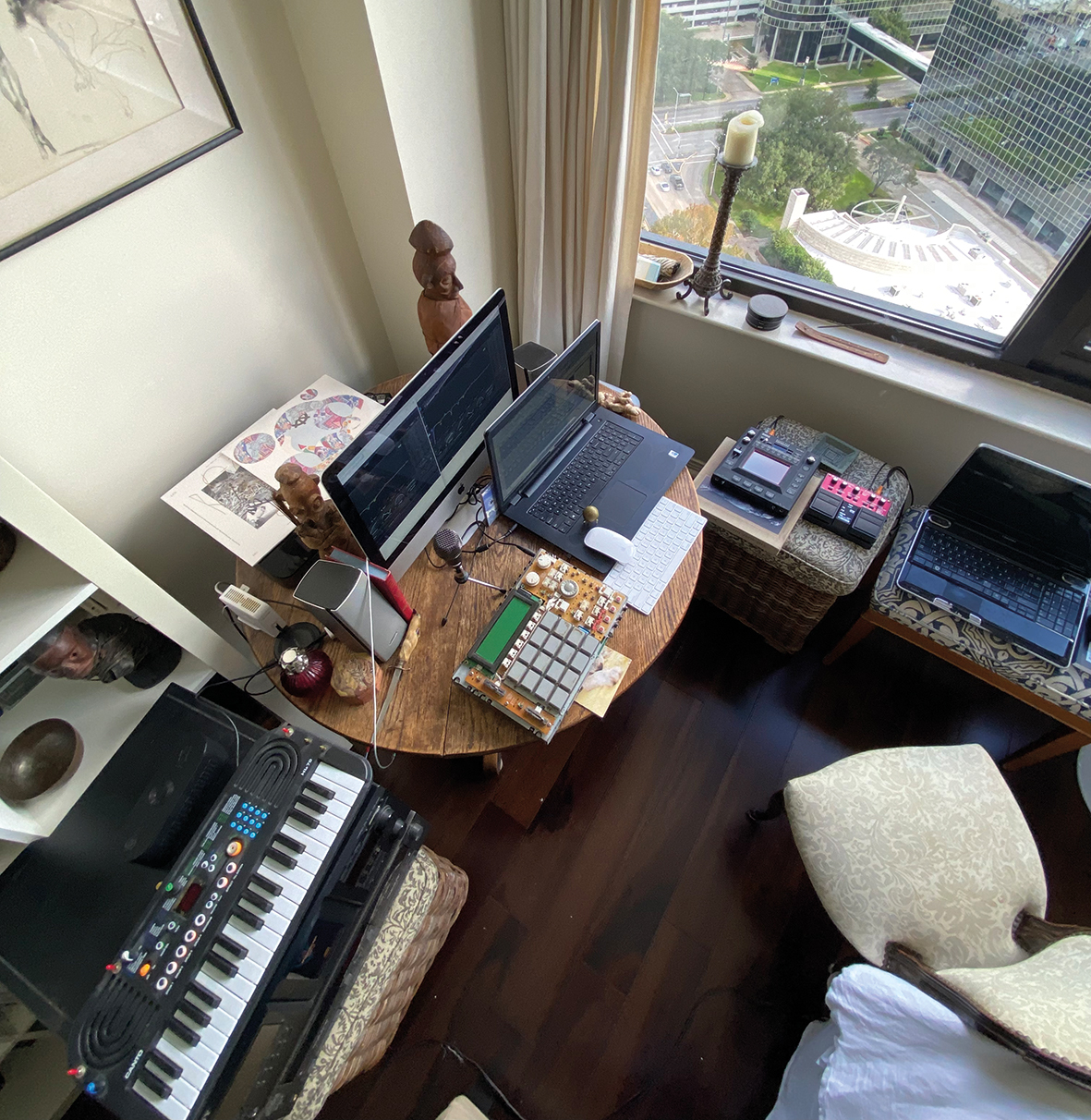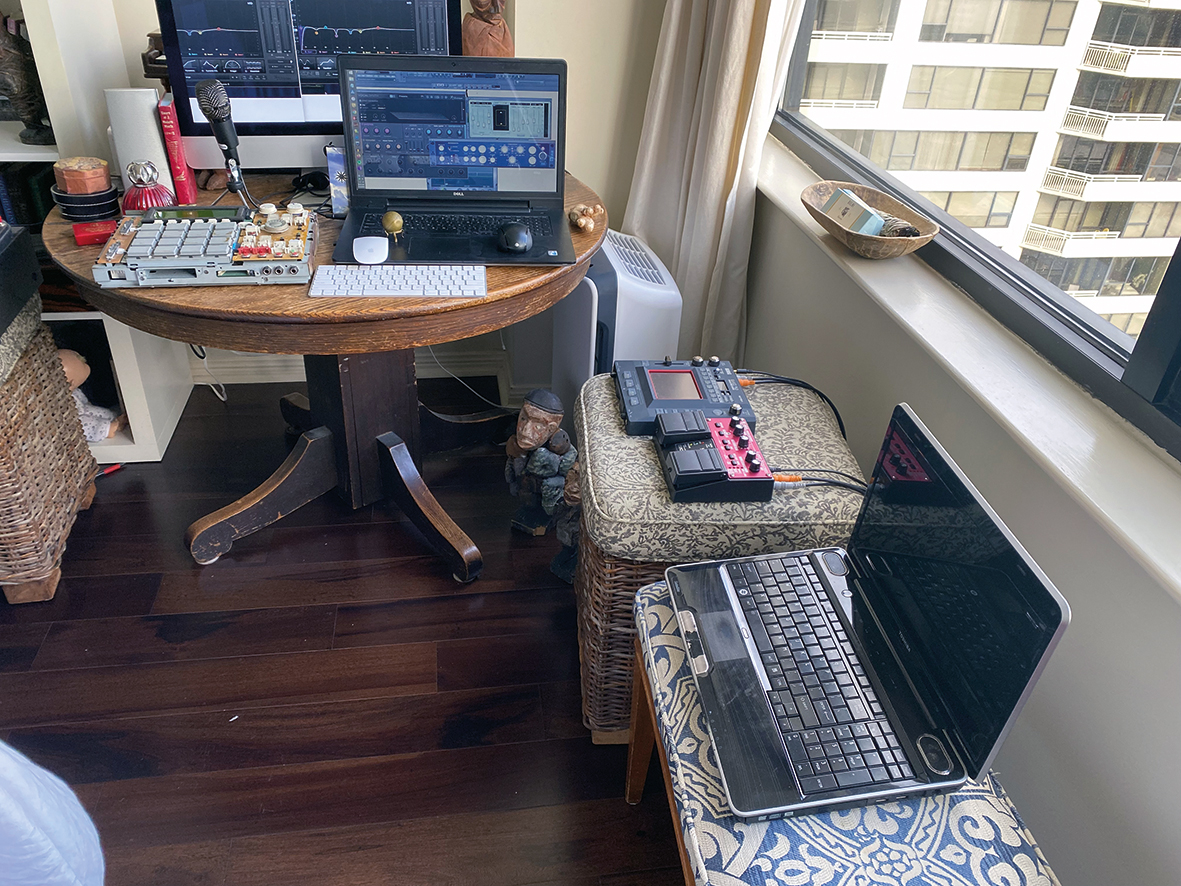Rabit on the circuit-bent synths, hacked MPC and generative software behind new album What Dreams May Come
After a four-year hiatus, leftfield grime producer Rabit takes an ambitious new direction. Danny Turner unveils his 'Frankenstein' approach

Beginning his career in 2015 with experimental grime albums Communion and Les Fleurs Du Mal, Eric C. Burton (aka Rabit) not only found himself flavour of the month but chosen to co-produce the track Losss on Björk’s Grammy-nominated album Utopia.
Where some artists might attempt to cash in on the collaboration, Burton remained more interested in following his creative instincts, serving up the uncompromisingly ambiguous LP Life After Death one year later.Having then released a series of mixtapes, Burton embarked on a new challenge to fully investigate the concept of collaboration.
His fourth album What Dreams May Come signifies a hugely eclectic and atmospheric shift of gears, whereby contributors including John Beltran, experimentalist JG Thirlwell (Foetus) and producer Maxwell Sterling coalesce with Burton’s eccentric use of circuit-bent machinery, modified synths and the algorithmic program, Nodal.
Would you say you always had a studious approach to production?
“I’m kind of old-school in that I studied the greats. Before I was on the internet or released music, if I found something by a producer that I was stuck on I’d load something up on the Akai MPC and literally try to unpack how they made the rhythms or the basslines. Dilla’s Ruff Draft and records by Madlib’s Quasimoto were super-influential to me. I was never a school person, but I’m very investigative and thirsty for knowledge. A lot of kids are like that, and a lot of us fall by the wayside because we’re not interested in getting a degree.”
How did you get involved in producing the Björk track Losss back in 2017?
“The guy that ran the label Tri Angle, which released my first album Communion, had some input on remixes for Björk’s previous record Vulnicura. It was during an era when the grime sound was very fresh and that whole experience was a little serendipitous, but I’ve learned as an artist that if you’re doing something unique then if you stick with it and have good intentions your music is going to find people.”
Want all the hottest music and gear news, reviews, deals, features and more, direct to your inbox? Sign up here.
People might imagine working with Björk would completely change your public profile. Was the reality very different?
“The funny thing about it was that I pretty much went on a five-year hiatus after that came out. I work very intuitively and do a lot of things that don’t make business sense. Obviously, the thing to have done right after that song came out would be to drop a project with a bunch of tracks that all sounded like Losss, but I’m not interested in collecting fans – it’s just not how I operate. I needed to investigate what I was interested in doing musically.”
You’ve been called a producer, composer and storyteller. That last word seems highly relevant in relation to your latest album, What Dreams May Come?
“It’s a term that I only started using this summer. I just felt that telling the story of being a Texas musician, my journey and that of my friends around me who make music, needed to be documented – otherwise, when we’re gone it will all be gone. I guess that I no longer need to wait for other people to break ground or make choices about my music relating to the world at large.”
You mentioned What Dreams May Come as being a time capsule of sorts?
“When I use the word storyteller that also includes the music that came before me that motivated me. When you were growing up, I’m sure you were a fan of artists or DJs that people had never heard of that ended up being more influential to you than some huge name. We all have a lineage and I’m really into remembering that and not acting like all my ideas came out of thin air.”
Is this the first time you wanted to work directly with other artists on a full-length album?
“Where I come from, the world of rap music was so different because it seemed like a world of managers and major labels. I always thought that to make an album like Prince Paul or Dr. Dre you needed to have a certain stature, a million dollar budget and know people. After I’d dropped a couple of albums I thought, wait, why go through all these people when I can just find artists adjacent to my scene and start making music with them?
I’m influenced by the Aphex Twin or Squarepusher vibe - finding something that you like and breaking it, whether that’s a plugin or a drum machine
“If I was to give advice to anyone it would be that. The worst thing people can do is say ‘no’ and their decision might not have anything to do with me as an artist, so I just continued to collect tracks and collage pieces of music and any time an idea came to me I’d hit somebody up and ask if they were down for working on it.”
You must have been particularly delighted to get JG Thirlwell from Foetus involved?
“He’s someone that’s compelling as a musician and always challenging the boundaries. With this album, I was really into bridging the gaps between generations and genres. He hadn’t heard my stuff before, but was down for it as soon as I hit him up and was very generous and open to experimentation. He’s a bit like me – a serial experimenter, and I’m always going to get along with people like that sonically.”

So the tracks were mostly written prior to you sending them to a particular artist to contribute?
“Some of the tracks have different workflows to them. For example, the spoken word interludes with Lagniappe and Boochie were made because I hit them up and asked them to record whatever they felt like on a voice note. Then, once the album had started coming together, I knew exactly where those tracks should fit and worked on creating a sound bed for them.”
The album’s very different to the grime music of your first two or three. Do you feel that part of your growth as an artist is about creating something more relatable to people?
“With my first album I was basically making grime tracks when Tri Angle approached me and thought I was doing something different that was bigger than the scene I was in. That was perfect as a debut, but there was no breadth in what I was doing – I was just sending tracks to grime DJs and happy if someone used them in a mix. To me, grime is about being competitive and my music was an extension of that.
None of the tracks have a traditional song structure; it’s about capturing a feeling
“A lot has happened since then. I make tons of things I don’t release and What Dreams May Come is a culmination of a growth in my sound and a maturity in realising that just because I make electronic music it doesn’t need to be anything – it’s all about challenging what a song or an album should be. As you can probably tell, none of the tracks have a traditional song structure; it’s about capturing a feeling.”
If we take a track like Epiphany, which is particularly surreal, what can you tell us about how it was pieced together alongside the various collaborators?
“That started with me going back and forth with John Beltran exchanging synth and ambient patches or textures until it got to a place where I had the bed of a song and would hear a voice that might sound great on top of that. But the contributions from Lauren Auder and Baby Blue were made singularly and edited at a later stage based on how they fit into the overall statement.
“Some people collaborate when they’re out of ideas, but when I collaborate with someone or reach out it’s because they do something that I can’t. It’s about pooling everyone’s strengths and making a statement.”
How did Maxwell Sterling fit into that process?
“Maxwell provided the bulk of the instrumentation, like the strings and the double bass. We’d worked together on a couple of live shows in 2019 and had a great rapport, but all of the music was made remotely.
“I finished everything in my own studio by collaging it all together and I really like that term because a perfect mixdown is a great thing, but the way I make music is based on feel. I generally don’t revisit sounds after the time they’re made – the space and the feel of the track is more important than whether something is technically sound, and I’m sure you can tell that [laughs].”
Many of the tracks are highly atmospheric. Is that
down to how you layer tracks or the effects used on certain instruments?
“My process is very effects and experiment-heavy. Taking a track like New Days, I put all these yelling and crowd noises through delays based on experiments where I’d have the delay going crazy.
“I’m influenced by people like Aphex Twin or the Squarepusher vibe of finding something that you like and breaking it, whether that’s a plugin or a drum machine, and I like to experiment with effects by breaking the sound, making an instrument do something new or layering it in a way that has an emotion to it. Not that those people don’t make beautiful music, but to me this album feels just as much like peak 4AD or a band like Coil.”
You appear to primarily work in the box alongside a few hardware toys…
“I typically like to experiment with one thing at a time. I work very quickly and don’t see the need for having tons of gear chained together. A lot of the fun I have with sound is about getting an idea, playing with a bunch of effects and calling it a day. I may do that hundreds of times and when it finally feels like I’m getting somewhere I’ll edit all that audio.
I typically like to experiment with one thing at a time. I work very quickly and don’t see the need for having tons of gear chained together
“For me, people who have a studio with one of everything connected tend to make tracks in a linear way. I don’t save projects, so when I say that I’m collaging I’m literally doing just that and have to EQ in a subtractive way or edit because I’m not able to EQ something. The approach is very Frankenstein and would probably make no sense to other musicians.”
Do you believe in squeezing the most out of an instrument?
“I’ve been influenced by people who work in a very bare bones way. The beatmakers I grew up on just used a Roland SP-404, E-mu SP-1200 or made a whole song on an Akai MPC. If you can do that on an MPC you’re a lot further along than someone who has an entire studio because it becomes more about your creativity and willingness to make a track.”
Does that make mixing problematic or does it just mean you’re happy to leave lots of sound artefacts in the mix?
“On the New Days track, which has lots of synth sounds and background vocal effects, I’m just going to treat the entire thing as a VST synth. If something’s in the way, I’ll just cut the frequency out and rely on a good mastering engineer. I’m very big on just getting on with the process – I’m not going to search for VSTs all day or look for problems in my mix and spend a lot of time working on them.
“I’ve got friends who work that way and want everything to be perfect – and that’s great if you want something to sound great in a club, but What Dreams May Come is not an album for clubs, so that’s not my concern.”

Talking of limitations, you once said Native Instruments and iZotope gave you all their software so you don’t need to buy gear anymore. Was that a flippant remark?
“With this album, there’s a good amount of acoustic instruments and samples that were used in creative ways, but I’m pretty much still going through those soft synths because if you have a well-rounded synth you can use it for a long time. I’ve just transitioned into collaborating with people who play instruments, letting those experts do their thing and blending that in with my own flow.”
Tell us about some of the modified equipment you’ve been using, particularly in relation to the Akai MPC…
“I’ve been using that for more than 15 years. One of the first things I did was to use a Japanese operating system called JJOS, which I don’t believe is updated anymore. It’s kind of like how a Tesla has certain things that you can unlock if you pay for them – all the technology is already in there, it’s just being paywalled.
I lost the outer casing of my MPC in a hurricane, so I just left it like that
“The MPC is the same, they basically use all the same chips but the housing is different, so with JJOS you could basically hack those software limitations using a compact flash card to create a version of the most expensive MPC in the cheapest model. At the time, that was the Akai MPC1000 and I used it for ages. When something on it broke one day I realised I could fix it, but then I lost the outer casing in a hurricane so just left it like that.”
What about the circuit-bent synth you have?
“That came from some people I found online who make circuit-bent stuff. It’s very cheap and small and the name is irrelevant because it’s worse than a Casio, but I’m super-big on merging hi-brow and low-brow synth recordings. I don’t know if they make the Alesis Andromeda anymore, but that’s a synth I’d love to have. It’s so big and expensive, but I’d love to rip the sound bank and merge it with a toy.”
You have some cassette decks, presumably to get a tape saturation effect on sounds?
“I like to mess with the Dolby sound reduction and play with the different buttons that you’re not going to get from messing with a plugin. I’ll make synth sounds on a soft synth, record them onto a cassette and rip those back in using the free software Audacity, which I actually use a lot. I may not even use all that stuff – it’s just an experiment and fun to play with!”
How does the algorithmic program Nodal help you generate the sounds you’re looking for?
“I’m not privy to the whole world of melodic phrasing – my melodic playing is quite intuitive and better suited to a shoegaze vibe where whatever feels good is right, so I’ll play in a progression and Nodal will embellish that, keep playing it as an infinite phrase and then I’ll just record any audio that jumps out at me. I think it’s boring to use generative software outright and just drop it into a track as a main feature. As interesting as certain artists might make that seem, the end result just doesn’t have enough soul.”
Rabit's new album What Dreams May Come is out now on Halcyon Veil.


